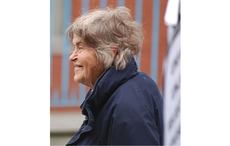The remains of a 29-year-old County Tyrone woman, murdered 183 years ago near Philadelphia, will be brought home and buried this week.
Catherine Burns was one of 57 Irish immigrants from Donegal, Tyrone, and Derry who were hired to build a railway between Philadelphia and Columbia. The site is known as Duffy’s Cut. Within six weeks of their arrival all 57 Irish immigrants were dead of cholera and, possibly, violence. They were buried anonymously in a mass grave.
In 1832, Burns, a widow at the age of 29, immigrated to America with her father-in-law, laborer John Burns, on board the ship John Stamp. After two trying months at sea, they arrived in Philadelphia on June 23, 1832.
Catherine was one of 70 residents of Tyrone among the 160 passengers to leave for a new life in the new world. Within eight weeks of their arrival, Catherine and John disappeared from the historic record.
Thanks to the Duffy’s Cut Project Burns' remains will be laid to rest at Clonoe, near Coalisland, County Tyrone. The Duffy's Cut site and its story have been brought to light over the past 12 years by brothers Frank and William Watson, a Lutheran minister and a historian at Immaculata University. The Watson brothers, along with their colleague Earl Schandelmeier, founded the Duffy’s Cut Project in 2002.
Dr William Watson, professor of history at Immaculata University, told the Belfast Telegraph that Burns’ skull shows "massive perimortem violence by means of a sharp implement which would have caused her death."
He added, "We believe Catherine was murdered in an attempt to contain the cholera epidemic, which the locals believed was being spread by the immigrant railroad workers.
"The workers were a convenient scapegoat for the community, which did not understand the etiology of the disease."
Watson believes that the first seven bodies they excavated had been healthy people who had fled to the valley. They were murdered. Their bodies show no signs of defensive wounds. One man died from being shot in the head after being struck by with an axe.
Watson also commented on the fact that the coffins were sealed with a large number of nails – on average more than 100. He said this was to prevent them from being opened. The coffins were brought back to the valley to be buried.
The Duffy’s Cut Project is an online archival and archaeological search into the lives and deaths of these Irish immigrants. Those involved hope to provide some insight into the attitude about industry, immigration and disease in Pennsylvania at that time.
A memorial sign at the Duffy’s Cut site reads:
“Nearby is the mass grave of fifty-seven Irish immigrant workers who died in August, 1832, of cholera.
"They had recently arrived in the United States and were employed by a construction contractor, named Duffy, for the Philadelphia and Columbia Railroad.
"Prejudice against Irish Catholics contributed to the denial of care to the workers. Their illness and death typified the hazards faced by many 19th century immigrant industrial workers."
Next Friday the town of Clonoe will come together to lay Burns to rest. She is the second of the Duffy’s Cut victims to be identified and buried at home in Ireland.
The first body identified was that of 18-year-old John Ruddy from Donegal, who was re-interred at Holy Family Cemetery in Ardara, County Donegal on March 2, 2013.
Another five men were buried at West Laurel Hill Cemetery in Bala Cynwyd, PA on March 9, 2012.
On Friday night an Irish wake, with traditional music and dance, will be held for Catherine Burns followed by a funeral mass and burial at Clonoe Chapel, on Sunday.
In the parish bulletin Father Benny Fee wrote, “'Les Miserables' is a great musical and my favorite song in it is 'Bring Him Home.' And these days I find myself humming that tune because the parish is busy preparing to bring not him but to bring her home.
"After being buried in an unmarked grave for over a century Catherine Burns is on her way home to her native Tyrone to rest in Clonoe."
Fee added that Burns’ story was “not unique.” He wrote, “Her story of hopes dashed and dreams shattered is not unique. So in honoring the homecoming of Catherine we are honoring countless other exiles who sailed out of Ireland in the hope of a new life far from home but did not find the streets paved with gold."
The rest of the victims of Duffy’s Cut remain unidentified, but Frank Watson told IrishCentral earlier this year that he and the rest of the Duffy’s Cut Project team hope to continue the dig at Duffy's Cut, pending ongoing negotiations with Amtrak, who own the land.
It is their mission, he said, “to make the recovery of the rest of the Irish laborers buried there possible, and thus to tell the full story of those who lost their lives helping to build America.”




Comments